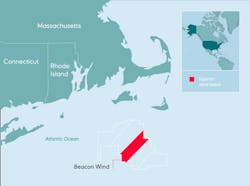OTC 2021: Beacon Wind project proceeding on schedule, says Equinor official
Offshore staff
HOUSTON – Offshore wind projects are moving into an era of rapid growth, and developers must allocate sufficient resources into project planning and permitting for the industry to advance. Those were among the key themes offered by Scott Lundin, Head of Permitting for Equinor Wind, at a panel on the opening day of the Offshore Technology Conference in Houston.
Lundin’s presentation, “Shaping the future of energy together,” focused on issues related to project permitting, materials procurement and power transmission for the US offshore wind industry. He related these themes to examples taken from the Beacon Wind project, which is expected to provide 1,230 MW of offshore wind power to the State of New York.
Beacon Wind is being developed by Equinor and bp, and will be located 20 mi (32 km) south of Massachusetts and 60 mi (97 km) offshore New York. It is expected to begin operations in 2028.
Lundin observed that developers need to plan on spending three to five years in the permitting phase, before any construction can begin. Ample time must be allocated to working with local stakeholders and commercial interests, he said. For example, Lundin noted that the permitting schedule for Beacon Wind will run from 2019 to 2025.
He also noted that nearby wind facilities will underscore the need for planning and partnering. For example, proper turbine spacing planning will be vital. There will also likely be a number of export cables running from offshore wind facilities to the New York City market area. With all of these proposed cables, “permitting and planning will be key,” Lundin said. “Beacon will be in a busy area.”
To help keep the project on schedule, Equinor selected MMT, an Ocean Infinity company, to conduct export cable route surveys for Beacon Wind this summer. MMT conducted a combination of geophysical, geotechnical, environmental, and benthic surveys along the export route of the Beacon Wind sites 1 and 2.
The data obtained from these surveys is vital to obtaining permits in a timely fashion, Lundin said. “It’s a data-intensive process, and data can’t be late. Our schedule is driven by the permitting process.” Construction on the Beacon Wind project is expected to start in 2025.
Speaking generally about the US offshore wind energy industry, Lundin noted that “every survey will be critical for the advancement of the US offshore wind energy industry. Impact areas must be defined before a survey can start.” The careful delineation of those impact areas, and the results from those surveys will set expectations for the US offshore wind industry going forward, he said.



